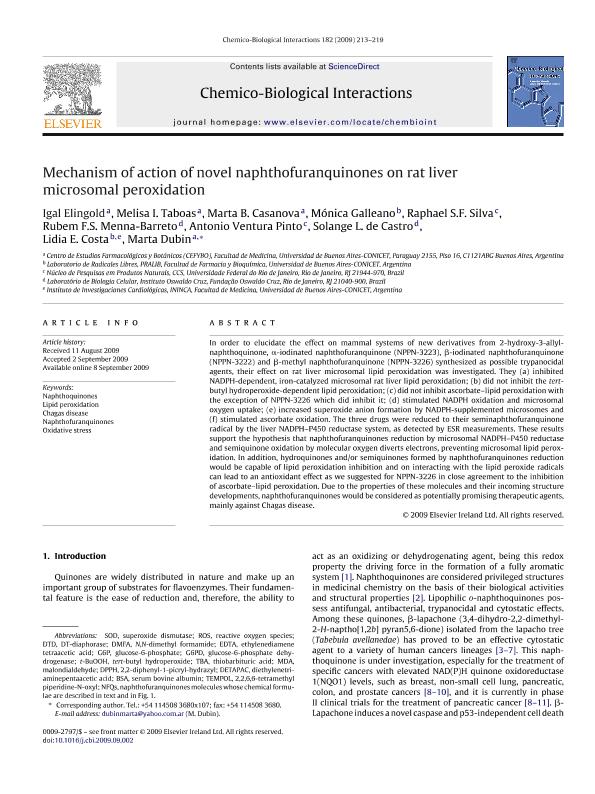Artículo
Mechanism of action of novel naphthofuranquinones on rat liver microsomal peroxidation
Elingold, Igal ; Taboas, Melisa Ivana
; Taboas, Melisa Ivana ; Casanova, Marta Beatriz
; Casanova, Marta Beatriz ; Galleano, Mónica Liliana
; Galleano, Mónica Liliana ; Silva, Raphael S.F.; Menna Barreto, Rubem F.S.; Ventura Pinto, Antonio; de Castro, Solange L.; Costa, Lidia Esther
; Silva, Raphael S.F.; Menna Barreto, Rubem F.S.; Ventura Pinto, Antonio; de Castro, Solange L.; Costa, Lidia Esther ; Dubin, Marta
; Dubin, Marta
 ; Taboas, Melisa Ivana
; Taboas, Melisa Ivana ; Casanova, Marta Beatriz
; Casanova, Marta Beatriz ; Galleano, Mónica Liliana
; Galleano, Mónica Liliana ; Silva, Raphael S.F.; Menna Barreto, Rubem F.S.; Ventura Pinto, Antonio; de Castro, Solange L.; Costa, Lidia Esther
; Silva, Raphael S.F.; Menna Barreto, Rubem F.S.; Ventura Pinto, Antonio; de Castro, Solange L.; Costa, Lidia Esther ; Dubin, Marta
; Dubin, Marta
Fecha de publicación:
12/2009
Editorial:
Elsevier Ireland
Revista:
Chemico-biological Interactions
ISSN:
0009-2797
Idioma:
Inglés
Tipo de recurso:
Artículo publicado
Clasificación temática:
Resumen
In order to elucidate the effect on mammal systems of new derivatives from 2-hydroxy-3-allyl-naphthoquinone, á-iodinated naphthofuranquinone (NPPN-3223), â-iodinated naphthofuranquinone (NPPN-3222) and â-methyl naphthofuranquinone (NPPN-3226) synthesized as possible trypanocidal agents, their effect on rat liver microsomal lipid peroxidation was investigated. They (a) inhibited NADPH-dependent, iron-catalyzed microsomal rat liver lipid peroxidation; (b) did not inhibit the tert-butyl hydroperoxide-dependent lipid peroxidation; (c) did not inhibit ascorbate?lipid peroxidation with the exception of NPPN-3226 which did inhibit it; (d) stimulated NADPH oxidation and microsomal oxygen uptake; (e) increased superoxide anion formation by NADPH-supplemented microsomes and (f) stimulated ascorbate oxidation. The three drugs were reduced to their seminaphthofuranquinone radical by the liver NADPH?P450 reductase system, as detected by ESR measurements. These results support the hypothesis that naphthofuranquinones reduction by microsomal NADPH?P450 reductase and semiquinone oxidation by molecular oxygen diverts electrons, preventing microsomal lipid peroxidation. In addition, hydroquinones and/or semiquinones formed by naphthofuranquinones reduction would be capable of lipid peroxidation inhibition and on interacting with the lipid peroxide radicals can lead to an antioxidant effect as we suggested for NPPN-3226 in close agreement to the inhibition of ascorbate?lipid peroxidation. Due to the properties of these molecules and their incoming structure developments, naphthofuranquinones would be considered as potentially promising therapeutic agents, mainly against Chagas disease.
Archivos asociados
Licencia
Identificadores
Colecciones
Articulos(CEFYBO)
Articulos de CENTRO DE ESTUDIOS FARMACOLOGICOS Y BOTANICOS
Articulos de CENTRO DE ESTUDIOS FARMACOLOGICOS Y BOTANICOS
Articulos(IBIMOL)
Articulos de INSTITUTO DE BIOQUIMICA Y MEDICINA MOLECULAR
Articulos de INSTITUTO DE BIOQUIMICA Y MEDICINA MOLECULAR
Articulos(ININCA)
Articulos de INST.DE INVEST.CARDIOLOGICAS (I)
Articulos de INST.DE INVEST.CARDIOLOGICAS (I)
Citación
Elingold, Igal; Taboas, Melisa Ivana; Casanova, Marta Beatriz; Galleano, Mónica Liliana; Silva, Raphael S.F.; et al.; Mechanism of action of novel naphthofuranquinones on rat liver microsomal peroxidation; Elsevier Ireland; Chemico-biological Interactions; 182; 2-3; 12-2009; 213-219
Compartir
Altmétricas



